
How to Advertise on Walmart: A Definitive Guide
Claire Lee, Meghna Bhalla, July 29, 2021
With global eCommerce sales at an all-time high in 2020, every business is actively looking for more opportunities to diversify and expand in the online space, and Walmart is undoubtedly a popular channel to consider. As the second-largest eCommerce marketplace with more than 150 million omnichannel customers each week, this means getting your brand in front of shoppers is getting increasingly difficult as Walmart continues to grow exponentially. If you sell products on the Walmart Marketplace or are a Walmart supplier, the only way to ensure that you're continuing to show up first where people are searching is through Walmart Sponsored Products.
In this definitive guide, we'll explore everything you currently need to know about Walmart Advertising from best practices, to strategies, and more.
A brief overview of what's included in this guide:
Walmart Ad Formats and Placements
Campaign Creation
Keyword Strategy
Reporting
Part 1: Walmart Ad Formats and Placements
The main method of advertising on Walmart.com and Online Pick up and Delivery (OPD) is through Cost-Per-Click (CPC) ads known as Sponsored Products. This ad type means you choose how much you are willing to bid on a product or keyword and are charged that amount only when a shopper clicks on your ad. Theses ads appear on organic search results, product detail pages and category pages on both Walmart.com and Online Pick up and Delivery.
For Walmart, you have to be a Walmart supplier or Marketplace seller to use Walmart Sponsored Products. Both types need to apply by submitting a request to wpasales@walmart.com to confirm their eligibility.
In addition to Sponsored Products ads, Walmart also offers a handful of other advertising options to qualified sellers/suppliers through their Managed Service offering. In order to apply, you must fill out their contact form.
Self-Serve Sponsored Products: Placements on Walmart.com and Online Pick up and Delivery
Walmart uses unified Sponsored Products campaigns for both Walmart.com and OPD. This means that ads automatically serve in the most relevant placements across all of Walmart's digital properties. For example, if you sell ice cream, your ad would only serve on OPD. However, if you sell dog food, your ad can serve on both OPD and Walmart.com.
Let's dive deeper into each of the placements available on each channel.
Walmart.com
Search In-grid
Search In-grid ads can appear in search results, browse, category, and curated shelf pages, and look very similar to organic listings. Ads will be tagged with an inconspicuous "Sponsored Product" label just below the product image.
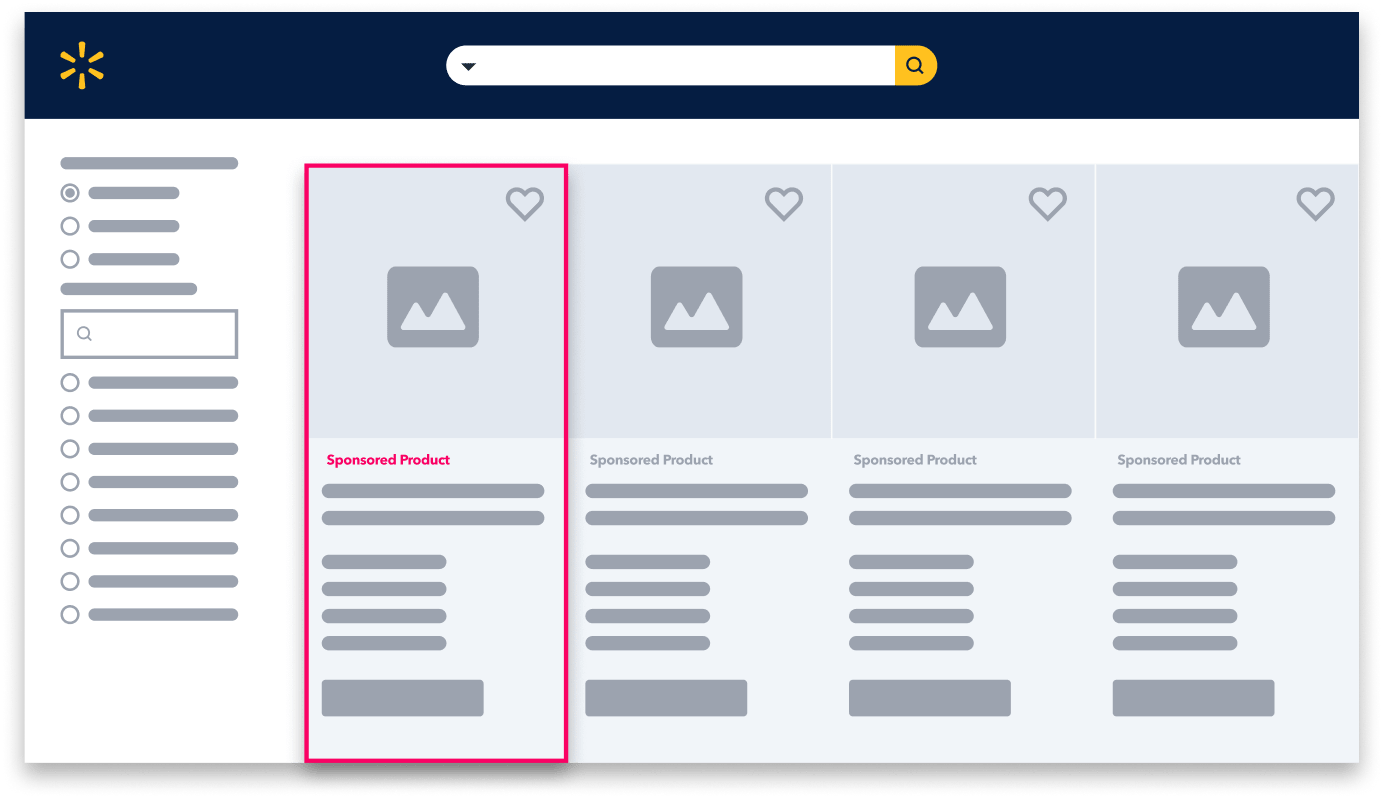
To be eligible for search in-grid placements, your products must meet some relevancy requirements that are unique to Walmart:
Your product must appear organically within the top 128 search results on a given search term to be eligible for search in-grid placements.
Your product must be in the same category as the search term or match to the category of a product in the top 20 organic listings.
Your promoted product needs to appear in a higher position than the organic ranking for the same product
These hurdles, although beneficial for the customer experience, can make new products difficult to advertise in-feed on strategic keywords due to lack of organic ranking and make it harder for new brands to break into categories.
To workaround these hurdles, you can:
Leverage Auto campaigns to hit other premium placements such as Buy Box, Stock Up and Homepage, which do not adhere to relevancy hurdles and will bring high visibility to newer SKUs.
Update item titles to include the most important keywords to those products to help drive relevancy.
Carousels
Carousel ads appear on search results, browse pages, category pages, curated shelf pages and on product detail pages with a maximum of 24 Sponsored Products per carousel. With this ad placement, your product does not need to appear organically within the top 128 of search results.

Ample visibility across site makes Carousel ads great for driving new-to-brand consumers browsing the category.
Buy Box Banner
The Buy Box ad is located on the product detail page of a relevant or complementary product just below the "Add to cart" button.
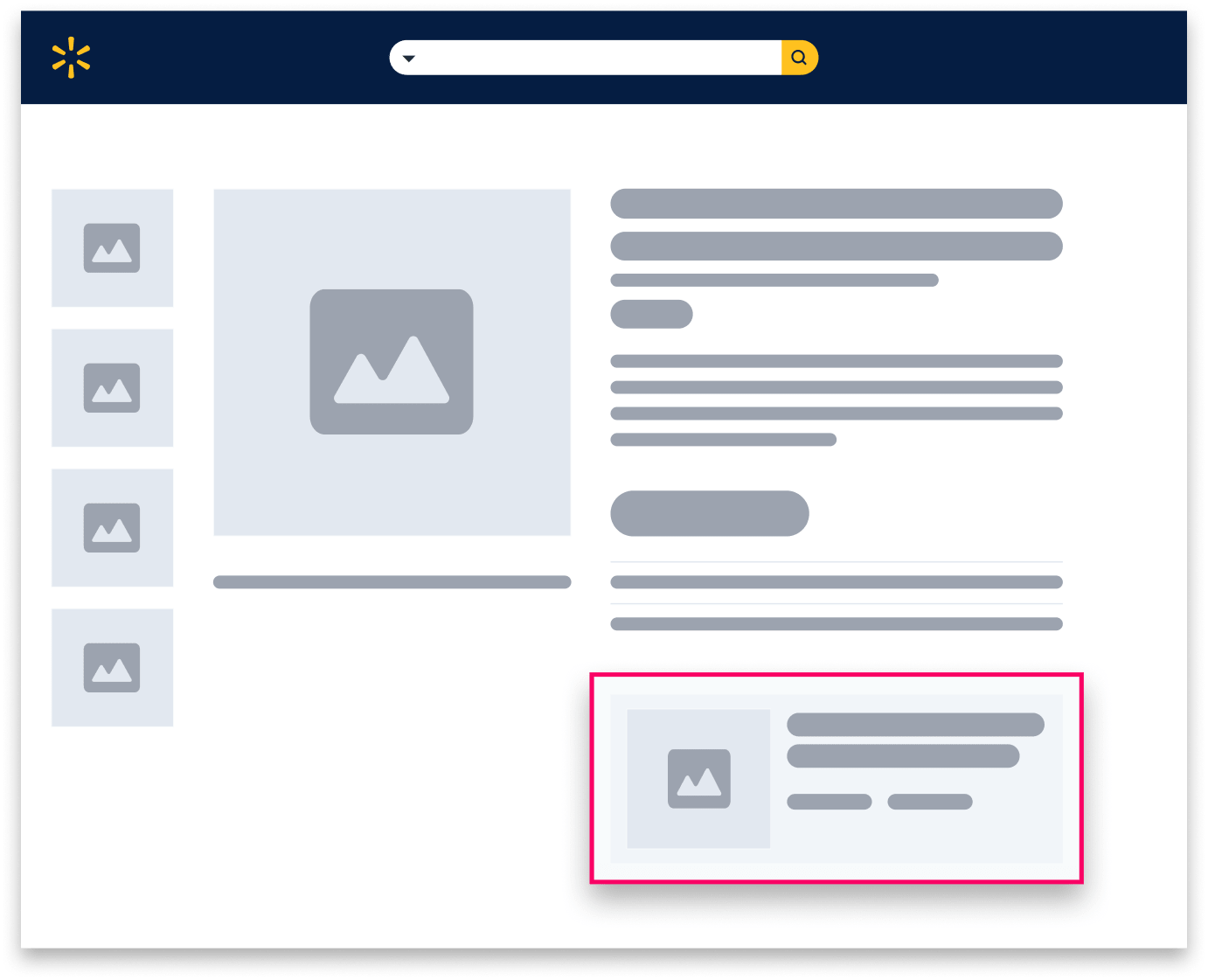
Since bidding on Competitor keywords is said to be technically prohibited on Walmart, the Buy Box placement becomes an excellent workaround to conquest against competition.
Online Pick up and Delivery (OPD) Placements:
Homepage
For Homepage placements, ads will appear within the "Featured items" carousel on the homepage of OPD. This allows for high visibility on the first page of search results and is great for new item releases, seasonal products and capturing new customers.
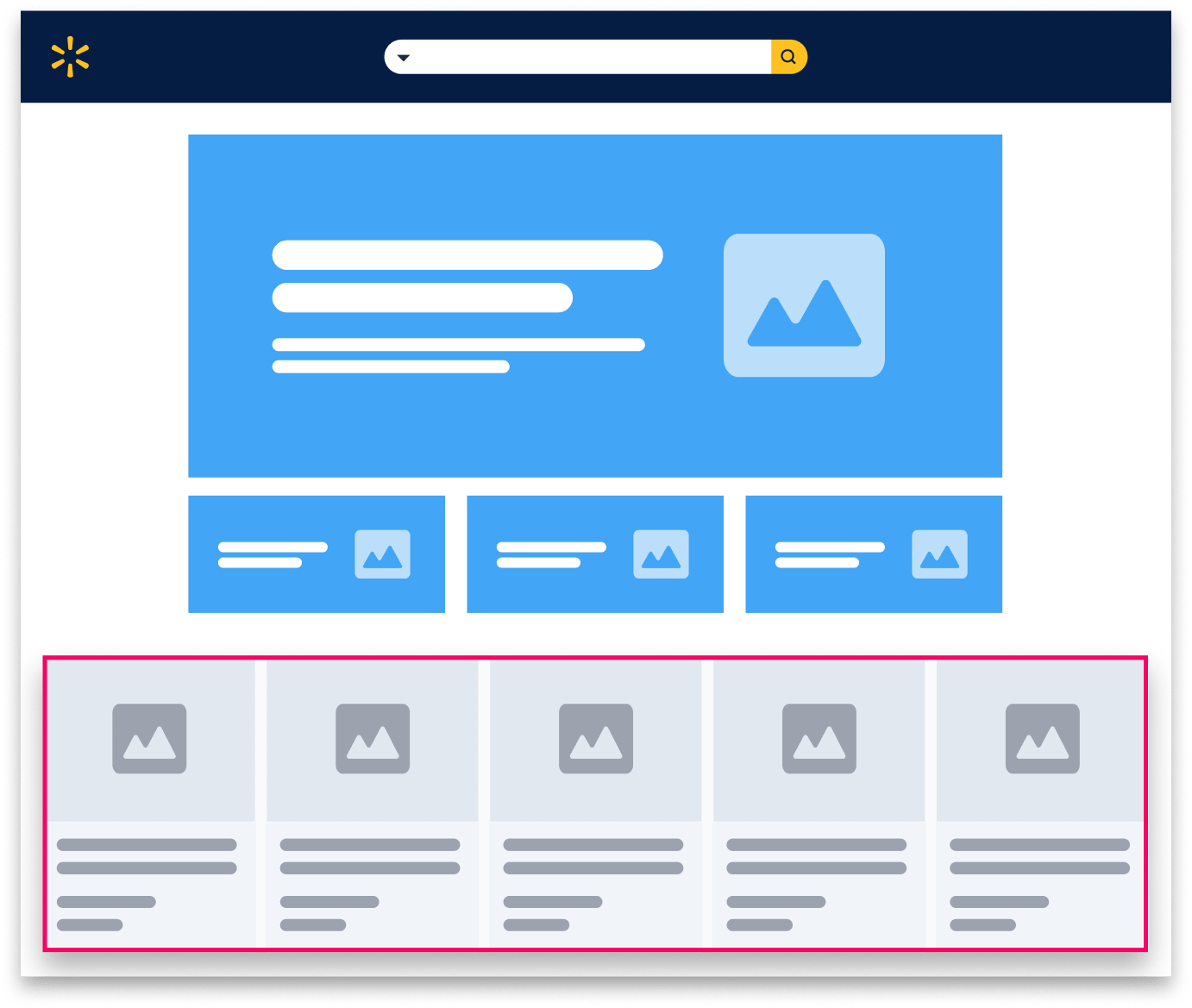
Personalized Carousel
Personalized Carousel placements have ads appear in sections such a "Recommended for you", "Best Sellers", "Featured Categories". These ads increase visibility to the most relevant audiences of your products as recommendations are all personalized to the shopper.
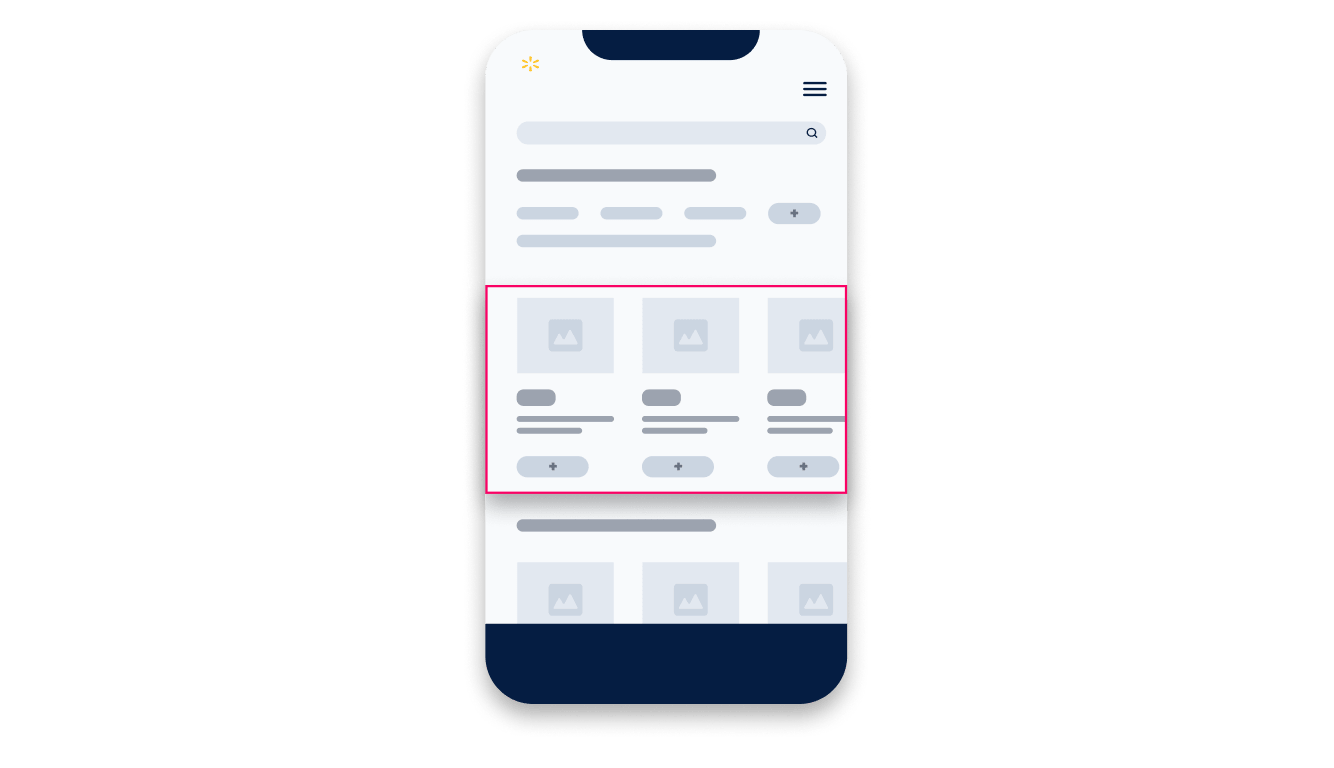
Search In-grid
Your ads appear at the top of pickup & delivery search and browse results to customers actively seeking products like yours. The same relevancy hurdles apply to be eligible for these in-feed placements within OPD as they do for Walmart.com.
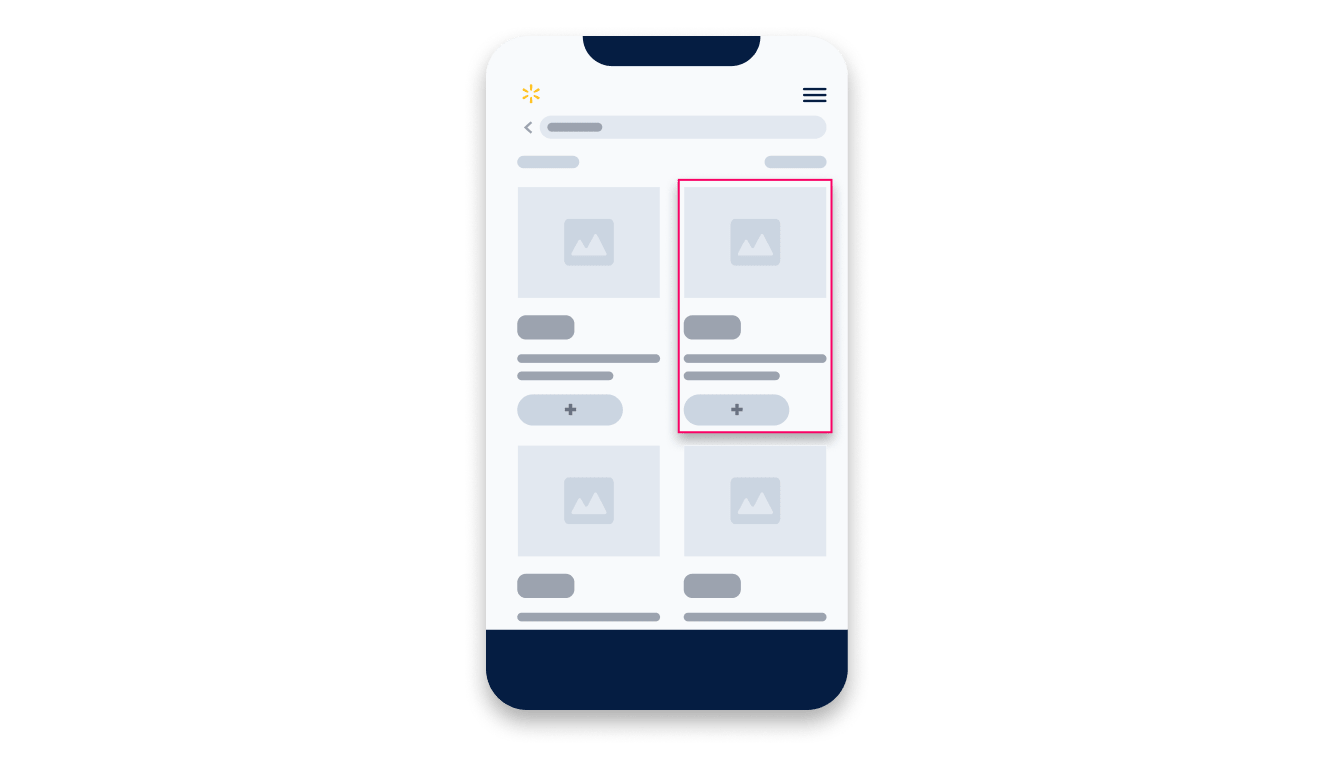
Stock-Up
Ads appear to select customers, based on their past purchase behaviour, new and seasonal items for discovery and other impulse purchases as they're finalizing their carts. Ads will appear in a position that reflect the product's organic search score ranking. These placements are great to increase purchase frequency of staple products or promote impulse-buy products.
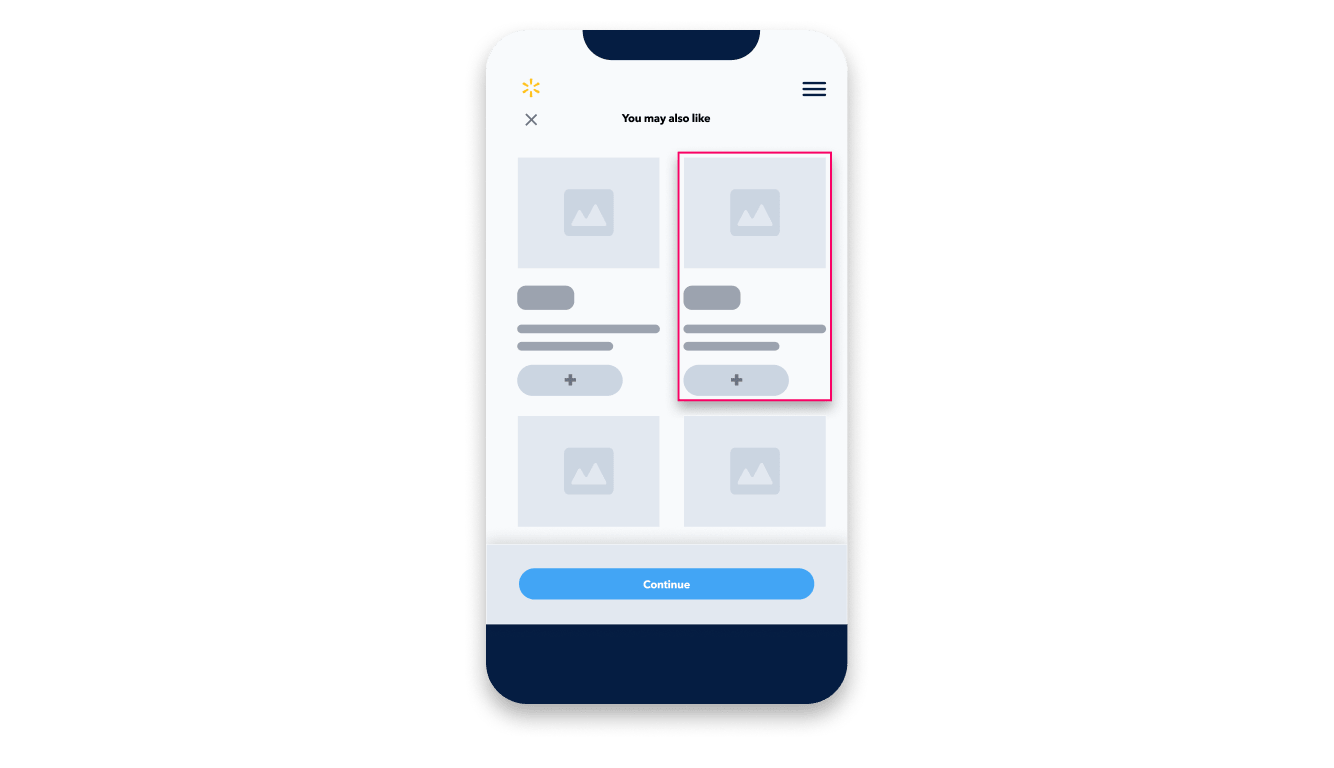
Part 2: Campaign Creation
Product Groupings
At Perpetua, we recommend grouping products that share over 70% of the same keywords together within the same campaign/ad group. Doing so will ensure that keyword targeting is tailored towards specific characteristics of products and allow you to track performance accordingly.
In addition to grouping products that share a significant volume of keywords, it's a good idea to group together products that fall within a similar price range. This is because the CPC (Cost-Per-Click) you're able to afford to achieve your desired return, directly relates to how products are priced.
Currently, due to Walmart minimum daily campaign budget requirement of $50, we tend to see many advertisers leaning towards grouping products at the ad-group level vs. the campaign-level.
Campaign Type
Walmart.com offers two different campaign types: automatic and manual. Perpetua recommends running both types of campaigns as auto campaigns will uncover valuable insights and manual will allow for greater control.
Overview of differences in campaign types:
Automatic
Walmart will decide when to display ads based on automatic relevancy
Bids are set at the item-level
Placements: Search In Grid, Buy Box, Carousel, Stock Up and Home Page
Reporting: Search term reports for in Search Ingrid
Manual
Added keywords are matched to search queries from shoppers on the Walmart marketplace
Bids are set at the keyword-level
Placements: Search Ingrid and Carousel
Reporting: Keyword Performance Report
Campaign Best Practices:
Auto
This is a content-driven campaign where Walmart will decide when to display your ad based on keywords identified from your product title, description, and other sections of your product detail page on top of the product category and related products.
Best Practices:
The mandatory minimum daily spend is $50 and optional minimum total budget is $100 for auto campaigns, ensure that you are budgeting accordingly
Run auto campaigns simultaneously to manual campaigns to continue to grow 128 organic rank for relevant keywords
Manual
Once you have a better understanding of well performing keywords, manual campaigns give you greater control and transparency as they allow you to select and target specific keywords of your choice.
Best Practices:
The mandatory minimum daily spend is $50 and optional minimum total budget is $100 for manual campaigns, ensure that you are budgeting accordingly
Utilize the placement inclusion option to identify whether you would like to include search carousel placement within your campaign *note: search in-grid is a required placement
Manual campaigns can only bid on singular terms, with the Walmart system extending that to plurals (ex. "tennis shoe" is a biddable terms and your campaign will also deliver on "tennis shoes")
Bidding
Walmart uses a first price bidding auction. This means that advertisers are bidding on keywords and items based on the maximum that they are willing to pay per click - the winner of the bid pays the exact value of their bid. However, to ensure there is some sort of regulation, Walmart also requires a maximum bid amount.
Best Practices:
Brands should consider what their max acceptable CPC is on Walmart, and use that as a guideline as they advertise on the platform - start lower and increase bids gradually
Automatic
As mentioned above, auto campaigns are optimized using Walmart's algorithms to determine the best placements for your ads. These placements are based on keywords in your product title, descriptions, other listing sections, category, and related items. Therefore, it is important that all of this information is relevant and up to date.
Best Practices:
The minimum bid amount is $0.2, but we recommend starting between $0.3-0.50. This will result in higher spend as you will win more premium placements such as in-grid and Buy Box
Set your CPC bid at the product level and add bid multipliers for specific premium placements
Utilizing lower base bids and then applying placements multipliers on higher value placements will allow you to achieve greater efficiencies.
Manual
Bidding for manual campaigns is relatively straightforward as once you have identified your strategic keywords, you can set a max bid amount for each keyword based on your desired CPC.
Best Practices:
The minimum bid amount is $0.3, but we recommend starting between $0.5-0.75
Set your phrase match bid lower than your exact match bid as $0.01 can make a difference with a first price auction if a phrase or exact match bid were the win the auction
With a first-price auctions, it's crucial to use an explorative bidding strategy. By starting low and increasing bids gradually, you can determine the optimal value for a given keyword/product and avoid overspending. With Perpetua, we'll manage all keyword changes on your behalf to ensure you are scaling as efficiently and effectively as possible.
Bid Multipliers
Both automatic campaign and manual campaign have the option to utilize a bid multiplier. These multipliers allow the bidding for specific prime placements and platforms to be increased by a % that is set by the advertiser.
Placement Multipliers
As mentioned above, there are a number of placements available on Walmart - however, certain placement multipliers are restricted to only auto campaigns.
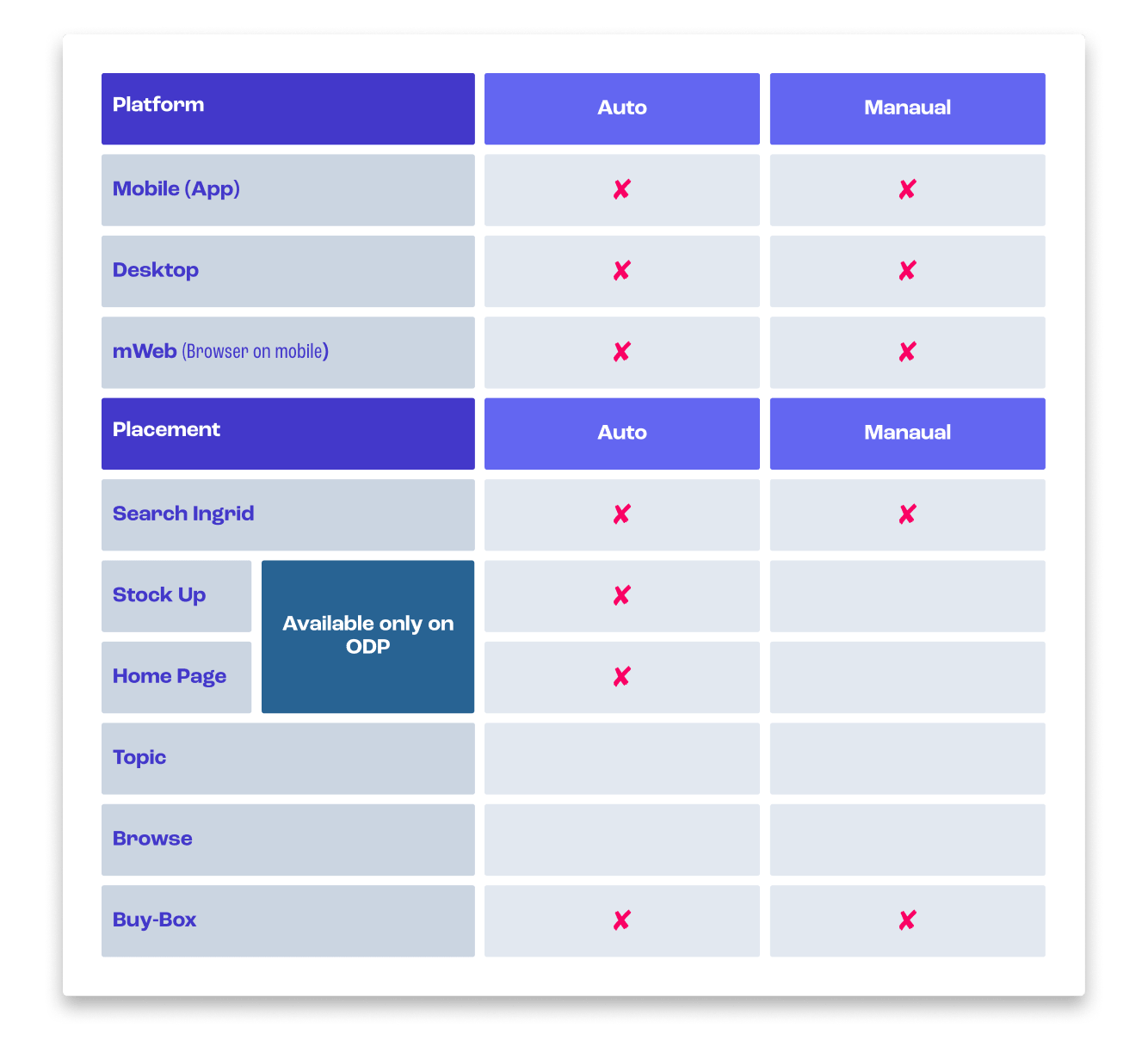
Platform Multipliers
As consumers are using Walmart.com from various devices, advertisers are able to add multipliers onto various platforms such as desktop, mobile and mWeb.
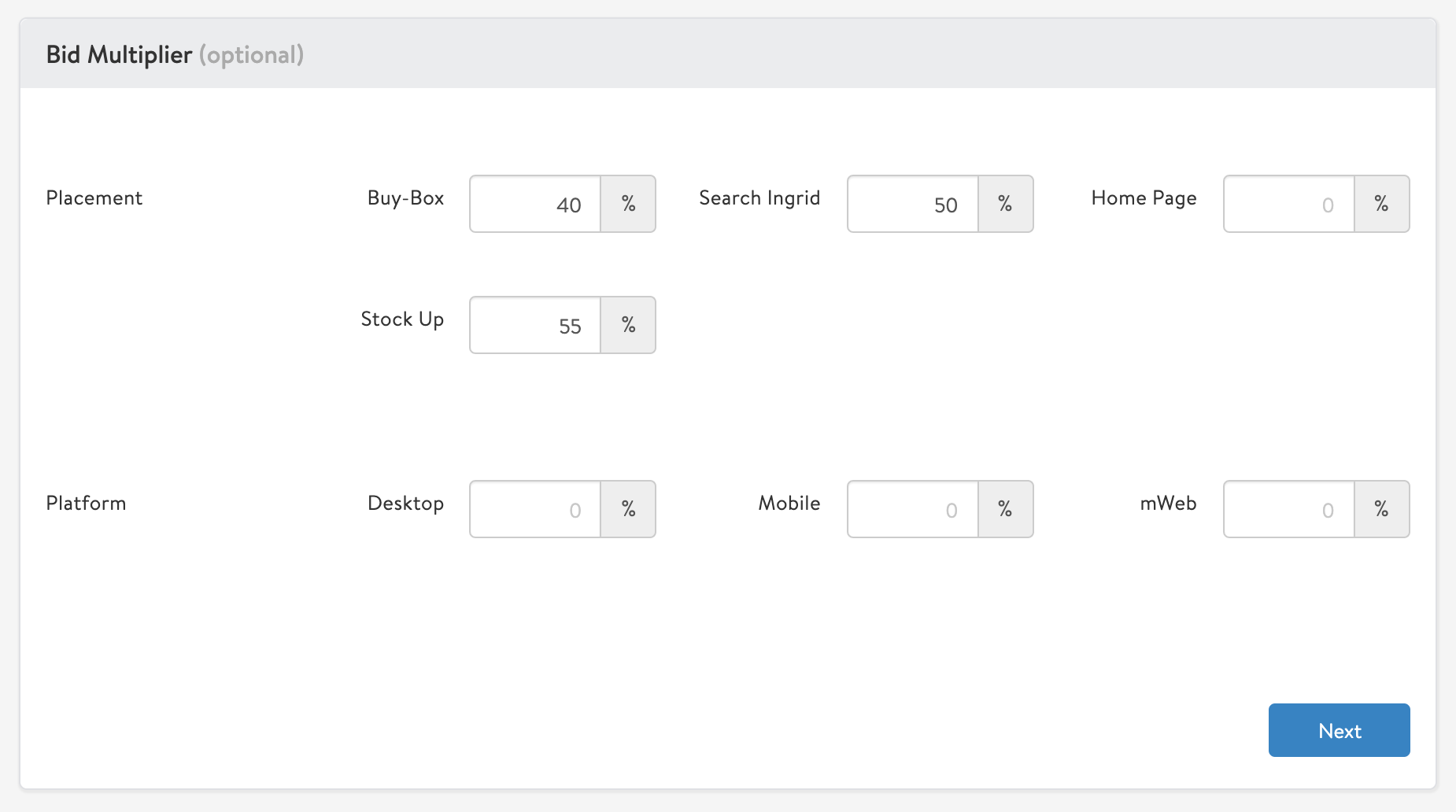
Note:
If you decide to use both placement and platform multipliers, they will be added together:
For example:
Starting bid:
$3.00
Buy-Box Multiplier:
60%
Desktop Multiplier:
180%
Resulting bid for buy-box position on desktop:
[$3.00 * (1+60%)] + [$3.00 * (1+180%)] = $13.2
Part 3: Keyword Strategy
If you are familiar with advertising on other marketplaces such as Amazon, you will find that keywords on Walmart are similar in a few ways:
Walmart supports all 3 match types: Exact, Phrase, and Broad
You must harvest your own keywords into manual campaigns
However, keywords on Walmart differ in that:
It does not support negative matching
Does not support product targeting - only keyword targeting at this time
Branded Keywords
Branded keywords can be used as a part of your brand defence strategy, but are not a requirement. There is a fine balance here between growth and brand defense. While you will typically see the lowest CPC and highest ROAS on your branded keywords, to ensure ad spend is incremental, we suggest only allocating a small portion (if any) of your budget to branded keywords.
Category Keywords
Category keywords, such as "dog food" or "t-shirts" is where we currently see the largest opportunity for growth on Walmart. Due to the lower competition over ad real estate across the Walmart Marketplace, we find that these keywords can be won with a CPC much lower than what you would see on Amazon, allowing you to achieve a sustainable ROAS, drive incremental sales, and directly improve your product's organic ranking.
Competitor Keywords
Conquesting - bidding and winning on competitor keywords - is often used as a way to steal marketshare from competitors. However, Walmart does not want conquesting to occur in its current state, and has taken strides to stop it. As of now, search in-grid conquesting is difficult.
A workaround is to leverage the buy-box ad inventory to conquest against competition via auto campaigns and fine-tuned bid multipliers on that placement.
Reporting
At Perpetua, we provide custom reports to all clients, ensuring your brand has clear visibility into how ads are performing and the strategy behind our approach to success.
We are also currently building a self-serve reporting tool which will allow brands to view Walmart performance alongside their Amazon and Instacart marketplaces which are already visible in our app.
Attribution
Walmart allows users to set a custom post-click attribution window of 3, 14, or 30 days.
Perpetua recommends using an attribution window of 30 days to measure performance. This ensures a wide enough window to measure all sales attributed to paid advertising clicks are captured.
Want to learn more about how you can grow your Walmart eCommerce presence? Reach out to us at hello@perpetua.io or speak with your Data Strategist, and we would be happy to help you.
To get started or learn more about how Perpetua can help you scale your Amazon Advertising business, contact us at hello@perpetua.io